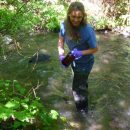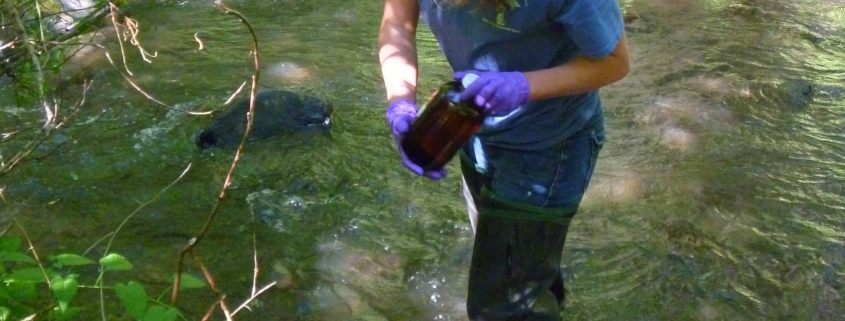Hood River Pesticide Stewardship Partnership
The Oregon Department of Environmental Quality (DEQ) uses Pesticide Stewardship Partnerships (PSP) to identify potential problems and improve water quality associated with pesticide use around Oregon.
Established in 2000, the PSP approach uses local expertise combined with water quality sampling results to encourage voluntary changes in pesticide use and practices. These changes can lead to measurable environmental improvements, thus making water safer for aquatic life and humans. Healthier rivers and streams are essential for communities that rely on them for drinking water or manufacturing processes, for people and fish who swim in these waters, and for many other uses.
The partnerships use both water quality and crop quality as measures of success. Pest management and water quality management must both be effective for long-term stewardship of natural resources.
Early Success Stories
Working closely with local stakeholders in the early 2000s, DEQ started two pilot projects in Columbia Gorge watersheds: Hood River and Mill Creek. DEQ and other partners assessed whether currently used pesticides were detectable in local surface waters at concentrations of concern. In both basins, initial data showed repeated detections of the pesticide chlorpyrifos at levels above state water quality standards. Hood River also had water samples that didn’t meet standards for the insecticide azinphos methyl, and Mill Creek had elevated levels of the insecticide malathion. Local partners, including Columbia Gorge Fruit Growers and the Oregon State University Extension Service used the water quality data and local expertise to help pesticide users implement best management practices to reduce the risk of drift, runoff and leaching of pesticides into area waterways.
Within a short time frame both pilot projects showed substantial improvements in water quality associated with changes in pesticide management practices. Improvements in detections of chlorpyrifos the Hood River watershed are shown on the graph below.
Growth of the PSP Program
The Hood River and Mill Creek successes showed that the Pesticide Stewardship Partnership approach could be an effective, timely alternative to traditional regulatory approaches dealing with “non point” sources of chemicals in water, such as agricultural lands and residential areas.
DEQ secured federal grant funds to start similar projects in other parts of Oregon. To date, there are nine PSP watersheds in the state.
In addition, in 2009, the DEQ laboratory increased the number of pesticides it analyzes from 15 to 100. Since then, DEQ has been able to increase the number of pesticides it analyzes to over 120. As a result, the state can detect some newer-generation pesticides in PSP watersheds, while others have not been seen or are seldom detected. This data helps focus outreach and technical assistance efforts in the watersheds.
Hood River PSP Today
The Hood River PSP program has grown and changed over the years as well. Although sites have been added and removed over the years, DEQ has continued to analyze water samples from the same five sites for many years: Upper Neal Creek, Lower Neal Creek, Lenz Creek, Odell Creek, and the mainstem Hood River at the footbridge. In addition to grab (instantaneous) sampling, sediment samples and passive (long term deployment) samples have been taken at several sites. In recent years, all water samples have been analyzed for insecticides, fungicides and herbicides. In 2015, a third of the samples were analyzed for a suite of glyphosate and phenoxy (2, 4-D) herbicides.
Across the basin in 2015, there were only two samples that exceeded the EPA aquatic life benchmark – both were the herbicide diuron, detected on 3/24 in Neal and Lenz Creeks.
T he organophosphate insecticides chlorpyrifos and malathion were not detected in 2015. The most frequently detected pesticides were commonly used herbicides, such as diuron. Diuron was detected in about 65% of samples, but at very low levels, except for the exceedances mentioned above. Glyphosate and 2,4-D were only sampled three times during the 2015 sampling season, but they were detected with 25% and 42% frequency respectively, and again at very low levels. These herbicides are used by homeowners, on rights-of-way, and by agriculture.
he organophosphate insecticides chlorpyrifos and malathion were not detected in 2015. The most frequently detected pesticides were commonly used herbicides, such as diuron. Diuron was detected in about 65% of samples, but at very low levels, except for the exceedances mentioned above. Glyphosate and 2,4-D were only sampled three times during the 2015 sampling season, but they were detected with 25% and 42% frequency respectively, and again at very low levels. These herbicides are used by homeowners, on rights-of-way, and by agriculture.
Future Direction
The Oregon Water Quality Pesticide Management Team helps guide current and future direction for the Pesticide Stewardship Partnership program. The team includes DEQ, Oregon Health Authority, Oregon Department of Agriculture and the Oregon Department of Forestry. This inter-agency collaboration, along with the watershed-based partnerships, will ensure the program’s continued effectiveness and improvement.
What You Can Do
Landowners can do their part to minimize pesticide pollution by: 1) applying, storing, and disposing of pesticides according to the label, 2) using pesticides as part of a multi-pronged approach to pest control, with pesticide usage as a last resort, and 3) using the least-toxic pesticide possible to address the problem.
For more information about this team and its activities, see the Oregon Department of Agriculture page.
For More Information
Contact Kevin Masterson, DEQ toxics coordinator by email or 503-229-5615, or call toll-free in Oregon at 1-800-452-4011, ext. 5615.




